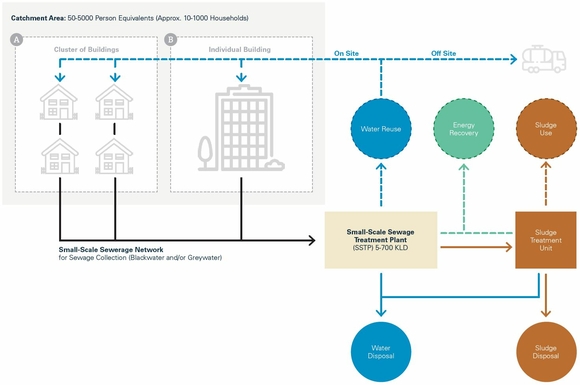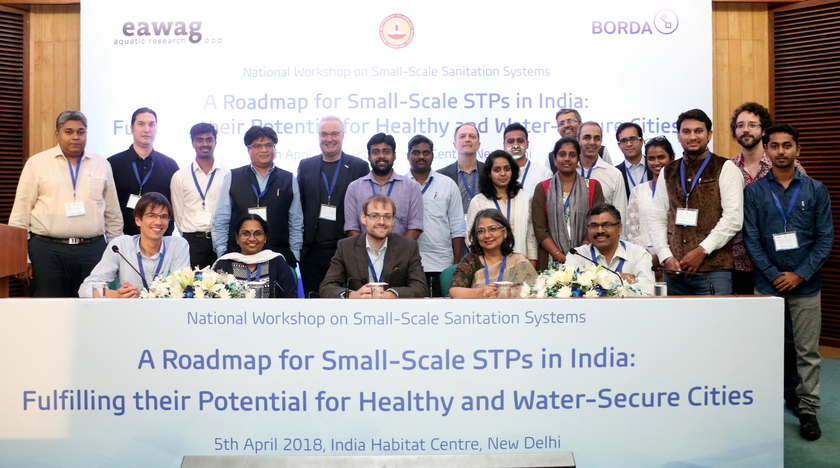Department Sanitation, Water and Solid Waste for Development
Small-Scale Sanitation Scaling-Up (4S) in South Asia

Evidence-based recommendations for small-scale sewage treatment and reuse through the assessment of more than 300 sanitation units
Small-scale (decentralised) sanitation has become a key element of city-wide inclusive sanitation. The relevance of small-scale sewage treatment and reuse systems is growing in South Asia’s urban areas. Thousands of systems have already been implemented in Indian cities, making an increasingly significant contribution to urban sanitation coverage and water reuse.
Eawag’s department Sandec partnered with the Indian Institute of Technology (IIT) Madras, BORDA (Germany), CDD Society (India), ENPHO (Nepal) and other partners to carry out the 4S Project, the first systematic assessment of small-scale sanitation (SSS) systems in South Asia. The 3-year research project was implemented from 2016 to 2019 and had three key outcomes:
- A landscape study along with governance and financial analyses of the on-going scaling-up of SSS in South Asia
- A detailed socio-economic and technical evaluation of more than 300 units mainly in India, but also in Nepal and Pakistan, including in-depth performance monitoring of 40 systems through sampling campaigns
- Policy recommendations for improving i) the design, implementation and operation, b) the governance framework and c) the financial sustainability of small-scale sewage treatment and reuse systems at scale
The project aimed to provide sound empirical evidence for future SSS sector investments in South Asia. The findings will allow decision-makers to make informed strategic decisions about sanitation and water management and to accelerate the provision of city-wide inclusive sanitation services in South Asia.
Terminology: What is Small-Scale Sanitation?
A small-scale sanitation (SSS) system refers to a sanitation system that collects and treats sewage at or near its point of generation, using a small-scale sewerage network and a small-scale sewage treatment plant (SSTP). A complete SSS system also includes a solution (on-site or off-site) for managing the sludge generated at the SSTP. SSS systems are sometimes also known as decentralised or distributed sanitation systems. Depending on the context, a SSS system can be designed to enable local water reuse, as well as energy and/or nutrient recovery (see Figure). In 4S, a SSS system is defined as one that serves 10-1000 households (or 50-5000 person equivalents, i.e. treating about 5-700 KLD [kilolitres per day = m3/day] of wastewater). SSS systems can be installed for clusters of buildings or for individual buildings, as well as for special applications such as public toilets.
Photos of typical SSTPs are shown here. The ConCaD Project produced a video that gives a good overview of small-scale (decentralised) wastewater treatment.
Why this Project?
In increasingly urbanised South Asia, conventional approaches to water supply and sewerage are reaching their limits, manifested by water scarcity and slow progress of wastewater infrastructure provision. At the same time, the number of SSTPs is increasing rapidly, and water reuse becomes more and more important, especially in India. However, there is currently a limited understanding of i) the specific role that SSS systems should best play in the future, ii) how good performance and cost-effectiveness can be ensured, and iii) how the ever-growing number of systems can be optimally regulated and managed.
4S aimed to establish the current status of SSS, and what is needed for it to fulfil its potential for healthy and water-secure cities. By learning from the current challenges and opportunities, 4S aimed to help develop a roadmap towards an enabling environment for successful and thriving SSS at scale.
The 4S Analysis Framework
To better understand the factors that impact the performance and sustainability of SSS initiatives at scale, 4S aimed to investigate the subject with a holistic approach that combined sanitation system assessments on the ground with analyses at the governance level (see Figure). Thereby, the research study considered all components that are needed for sanitation systems to achieve the desired performance:
- An enabling environment (see the six elements in the Figure)
- Strategic urban planning processes to ensure that SSS systems are implemented where they are most sustainable
- The correct design and implementation of systems, including the choice of appropriate technology
- The correct operation and maintenance (O&M) of systems, including the necessary management structures
- A monitoring and evaluation mechanism to support decisions regarding all the above components
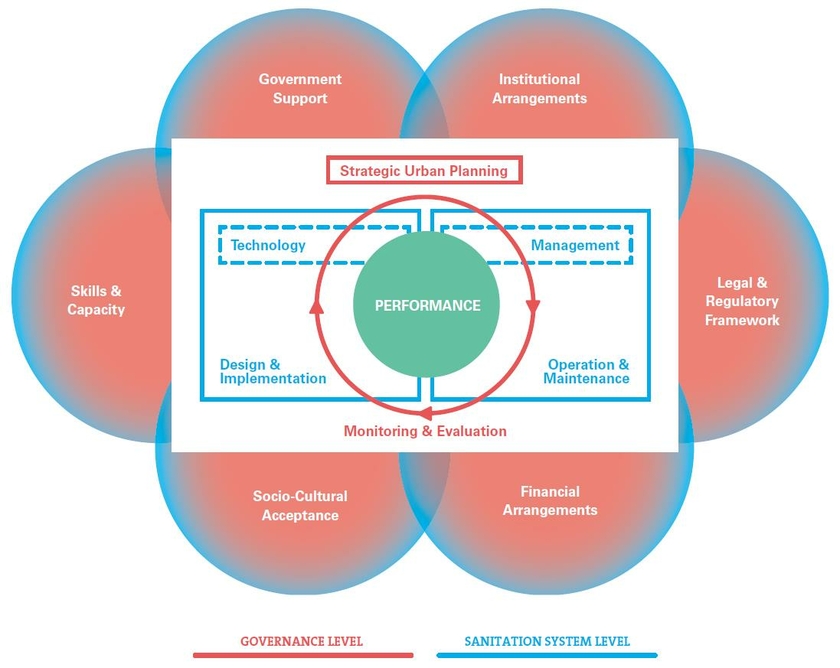
Research within the 4S Project
4S integrated a mixed methods approach that combined the analysis of existing systems in the field (micro level) with a review of the enabling environment for SSS systems (macro level).
The project included three main study components:
I. Technology, Implementation and Operation
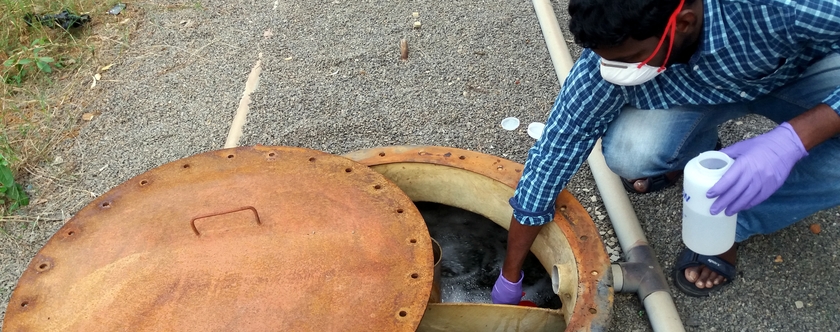
A. Landscape study
Available information on SSS systems in South Asia, private-sector actors, related policies, and findings from previous research were compiled in a desk-based landscape study.
B. Basic assessment of existing systems
To understand the factors that influence sustainability at the SSS system level, a basic assessment of systems was carried out. Design and implementation, O&M, management, socio-cultural and financial aspects were investigated in this part of the study. An exhaustive evaluation questionnaire and an inspection checklist were used to collect information on 279 SSTPs in India and 30 in Nepal. Study sites were pre-selected based on landscape study findings and interviews conducted with managers, operators and beneficiaries (users).
C. In-depth performance analysis
To gain an understanding of treatment performance and make comparisons with standards, a sampling campaign was carried out. It assessed the technical performance of 40 selected units (35 in India and 5 in Nepal), covering a representative range of treatment capacities, technologies and applications. Composite sampling of inlets and outlets over 24 hours (complemented with grab samples every 6 hours) was done three times at each site, and key water quality parameters were analysed.
Key Document:
II. Governance
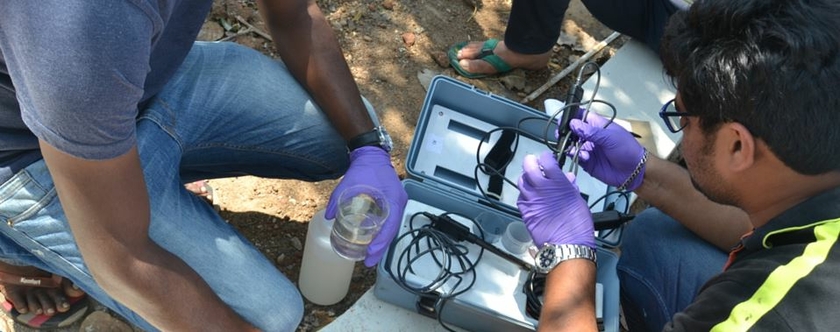
An analysis of policies, regulations and institutional arrangements identified the elements of an enabling environment required for SSS systems to fulfil their potential. Interviews were conducted with key sanitation stakeholders in order to understand their perspectives. Governance issues were analysed both from the top (the national and state policy level) and from the bottom (the impact at sanitation system level). The analysis looked at the factors that can enable or hinder the efficient design, implementation, operation and monitoring of SSS systems. This allowed the project to (i) identify strengths and weaknesses of the current governance framework, (ii) understand key institutional factors influencing the overall performance and success of small-scale wastewater treatment and its scaling-up process, and (iii) develop recommendations around which institutional structures should be improved or developed.
Key Documents:
Reymond, P.; Chandragiri, R.; Ulrich, L. (2020) Governance Arrangements for the Scaling Up of Small-Scale Wastewater Treatment and Reuse Systems – Lessons From India, Front. Environ. Sci. 8:72, https://doi.org/10.3389/fenvs.2020.00072
III. Financial Sustainability
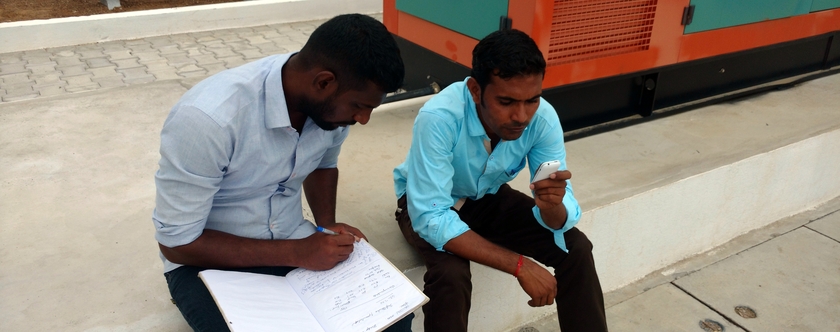
A financial analysis studied the life cycle costs (capital costs + operation and minor maintenance costs + capital maintenance costs) of commonly used SSTP technologies for a representative capacity range, as well as their variability. The analysis investigated the factors that affect costs of an SSS system, and delineated economies of scale. Data was collected primarily from SSTP designers and installers, but also from interviews with plant operators. The cost analysis together with a review of typical management models allowed the project to identify the main financial reasons for underperforming SSS systems, and to provide recommendations on how the financial sustainability of such systems could be improved.
Key Document:
- Rajan, P.; Aswani, K.; Rath, M.; Ulrich, L.; Lüthi, C. (2021). Financial Sustainability of Small-Scale Sanitation in India – Life Cycle Cost Analysis and Policy Recommendations. 4S Project Report Vol. III (Available soon)
Documentation
Further project reports will be available soon – please check back later or subscribe to our dissemination list here.
4S Project Publications
Project Reports and Documents
Journal Publications
Sandec News Articles
Workshop on a Roadmap for Small-Scale Sanitation Systems in India (New Delhi, 5 April 2018)
A Roadmap for Small-Scale STPs in India: Fulfilling their Potential for Healthy and Water-Secure Cities
-
Background Note and Final Programme [120 KB]
-
Press Release 3 April 2018 [77 KB]
Presentations
Workshop on a Roadmap for Small-Scale Sanitation Systems in Nepal (Kathmandu, 9 April 2018)
A Roadmap for Decentralised Wastewater Treatment in Nepal: Learning from the South Asian Experience
-
Background Note and Final Progamme [213 KB]

